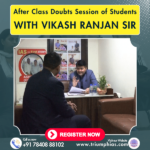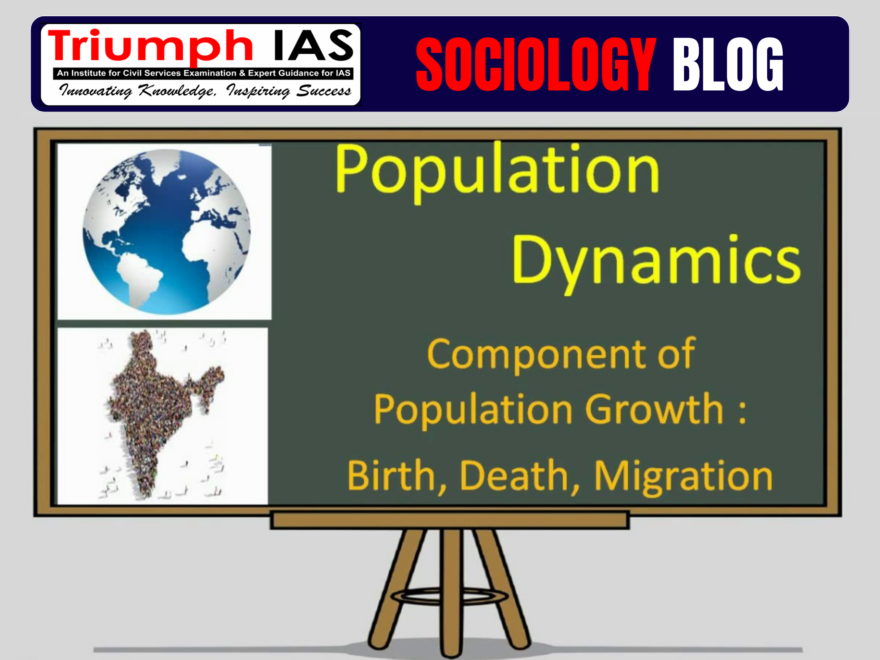Components of Population Growth: Birth, Death, Migration
Before 1931, both death rates and birth rates are high, whereas, after this transitional moment the death rates fall sharply but the birth rate only falls slightly.The principal reasons for the decline in the death rate after 1921 were
- Increased levels of control over famines and epidemic diseases. The later cause was perhaps the most important. The major epidemic diseases in the past were fevers of various sorts, plague, smallpox and cholera. But the single biggest epidemic was the influenza epidemic of 1918-19, which killed as many as 125 lakh people, or about 5% of the total population of India at that time.
- Improvements in medical cures for these diseases, programmes for mass vaccination, and efforts to improve sanitation helped to control epidemics. However, diseases like malaria, tuberculosis, diarrhoea and dysentery continue to kill people even today, although the numbers are nowhere as high as they used to be in the epidemics of the past Surat witnessed a small epidemic of plague in September 1994, while dengue and chikungunya epidemics have been reported in various parts of the country in 2006.
- Famines were also a major and recurring source of increased mortality. Famines were cause by high levels of continuing poverty and malnutrition in an agro climatic environment that was very vulnerable to variations in rainfall. Lack of adequate means of transportation and communication as well as inadequate efforts on the part of the state were some of the factors responsible for famines.
- However; as scholars like Amartya Sen and others have shown, famines were not necessarily due to fall in food grains production; they were also caused by a failure of entitlements’, or the inability of people to buy or otherwise obtain food
- Substantial improvements in productivity of Indian agriculture (specially through the expansion of irrigation); improved means of communication; and more vigorous relief and preventive measures by the state have all helped to drastically reduce deaths from famine.
Nevertheless, starvation deaths are still reported from some backward region of the country. The National Rural Employment Guarantee Act is the latest state initiative to tackle the problem of hunger and starvation in rural areas.
Unlike the death rate, the birth rate has not registered a sharp fall. This is because
- The birth rate is a socio-cultural phenomenon that is relatively slow to change.
- By and large, increased level of prosperity exerts a strong downward pull on the birth rate. Once infant mortality rates decline, and there is an overall increase in levels of education and awareness, family size begins to fall.
- There are very wide variations in the fertility rates across the states of India. Some states like Kerala and Tamil Nadu have managed to bring down their fertility rates (TFR) to 2.1 and 1.8 respectively. This means that the average woman in Tamil Nadu produces only 2.1 children, which is the ‘replacement level’ (required to replace herself and her spouse). Kerala’s TFR is actually below the replacement level which means that the population is going to decline in the future. Many others states like Himachal Pradesh, West Bengal Karnataka and Maharashtra have fairly low TFRs.
- But there are some states, notably Bihar, Madhya Pradesh, Rajasthan and Uttar Pradesh which still have very high TFRs of 4 or more. These few states already accounted for almost 45% of the total population as of 2001, and they will also account for about half (50%) of the additions to the Indian population up to the year 2026. Uttar Pradesh alone is expected to account for a little less than one quarter (22%) of this increase.
Causes of high birth rate
- Customs of Early Marriage : The high birth rate in our country is due to several factors. One of the factors is the customs of early marriage in our country, particularly in rural areas. It has been observed that persons who are married at an early age have more children. Laws have been made from time to time to stop the practice of child marriage. According to the latest law, it is illegal for a girl to marry before she attains the age of 18 years and for a boy to marry before he attains the age of 21 year.
- Illiteracy and Poverty : Illiteracy in our country is another factor for the high birth rate. In this context, education of women is very important It has been found that the families of illiterate women have more children. Poverty is also an important factor. For the poor people more children mean additional hands to earn. In the poor families the child starts earning at an early age. Therefore, the poor people tend to have more children to increase their income. But in reality having more children does not help. The poor people are often unable to feed and educate their children. These children remain illiterates and unskilled labour throughout their life.
- Preference for Male Child : In our country, there is a preference for the male child This kind of wrong attitude is found not only in the illiterate families but also among the literates. In many families, the desire for a male child results in having more children.
The unmanageable growth in population creates many problems. The country cannot provide notorious food to its people. There is a shortage of space and housing. Unemployment grows and the standard of living decline. Therefore urgent measures are needed to tackle the problems of population growth.
The problem is more acute in the rural areas where the majority of our people live. These people have to be made aware of the problem of population growth. They have to be told that it is now possible to plan the size of the family. People have to realize that it is our own decision which makes our family small or big. It is in our own individual interest as well as in the interest of the country that we should have a small family.
Age structure of the Indian Population
The age structure of the population refers to the proportion of persons in different age groups relative to the total population. The age structure changes in response to changes in levels of development and the average life expectancy.
- Initially, poor medical facilities, prevalence of disease and other factors make for a relatively short life span. Moreover, high infant and maternal mortality rates also have an impact on the age structure. With development, quality of life improves and with it the life expectancy also improves. This changes the age structure. Relatively smaller proportions of the population are found in the younger age groups and larger proportions in the older age groups. This is also referred to as the ageing of the population.
- The dependency ratio is a measure comparing the portion of a population which is composed of dependents (i.e.,elderly people who are too old to work, and children who are too young to work) with the portion that is in the working age group, generally defined as 15 to 64 years.
- A rising dependency ratio is a cause for worry in countries that are facing an ageing population since it becomes difficult for a relatively smaller proportion of working-age people to carry the burden of providing for a relatively larger proportion of dependents.
- On the other hand, a falling dependency ratio can be a source of economic growth and prosperity due to the larger proportion of workers relative to the non-workers. This is sometimes referred to as the ‘demographic dividend’, or benefit flowing from the changing age structure. However, this benefit is temporary because the larger pool of working age people will eventually turn into non-working old people.
India has a very young population, that is, the majority of Indians tend to be young, and the average age is also less than that for most other countries.
- The share of the under 15 age group in the total population has come down from its highest level of 42% in 1971to 35% in 2001.
- The share of the 15-60 age group has increased slightly from 53% to 59%, while the share of the 60+ age group is very small but it has begun to increase (form 5% to 7%) over the same period.
- But the age composition of the Indian population is expected to change significantly in the next two decades. Most of this change will be at the two ends of the age spectrum-as 0-14 age group will reduce its share by about 11% (from 34% in 2001 to 23% in 2026) while the 60 plus age group will increase its share by about 5% (from 7% in 2001to about 12% in 2026).
As with fertility rates, there are wide regional variations in the age structure as well.
- While a state like Kerala is beginning to acquire an age structures like that of the developed countries.
- Uttar Pradesh presents a very different picture with high proportions in the younger age groups and relatively low proportions among the aged
- India as a whole is somewhere in the middle, because it includes states like Uttar Pradesh as well as states that are more like Kerala.
The bias towards younger age groups in the age structure is believed to be an advantage for India. Like the East Asian economies in the past decades and like Ireland today, India is supposed to be benefiting from a ‘demographic dividend’. This divided arises from the fact that the current generation of working-age people is a relatively large one and it has only a relatively small preceding generation of old people to support But there is nothing automatic about this advantage-it needs to be consciously exploited through appropriate policies.
Does the changing age structure offer a ‘demographic dividend’ for India?
- The demographic advantage or ‘dividend’ to be derived from the age structure of the population is due to the fact that India is one of the youngest countries in the world. A third of India’s population was below 15 years of age in 2000. In 2020, the average Indian will be only 29 years old, compared with an average age of 37 in China and the Untied States, 45 in Western Europe and 48 in Japan. This implies a large and growing labour force, which can deliver unexpected benefits in terms of growth and prosperity.
- The ‘demographic dividend’ results from an increase in the proportion of workers relative to non workers in the population. In terms of age, the working population is roughly that between 15 and 64 years of age. This working age group must support itself as well as those outside this age group (i.e., children and elderly people) who are unable to work and are therefore dependents. Changes in the age structure due to the demographic transition lowers the ‘dependency ratio’, or the ratio of non-working age to working-age population, thus creating the potential for generation growth.
- But this potential can be converted into actual growth only if the rise in the working age group is accompanied by increasing levels of education and employment If the new entrants to the labour force are not educated then their productivity remains low. If they remain unemployed then they are unable to earn at all and become dependents rather than earners. Thus, changing age structure by itself cannot guarantee any benefits unless it is properly utilized through planned development The real problem is in defining the dependency ratio of non-workers to workers. The difference between the two is determined by the extent of unemployment and underemployment, which keep a part of the labour force out of productive work. This difference explains why some countries are able to exploit the demographic advantage while others are not.
- India is indeed facing a window of opportunity created by the demographic dividend. The effect of demographic trends on the dependency ratio defined in terms of age groups is quite visible. The total dependency ratio fell from 79 in 1970 to 64 in 2005. But the process is likely to extend well into this century with the age-based dependency ratio projected to fall to 48 in 2025 because of continued fall in the proportion of children and then rise to 50 by 2050 because of an increase in the proportion of the aged.
- The problem, however, is employment Data from the National Sample Survey studies of 1999-2000 and from the 2001 Census of India reveal a sharp fall in the rate of employment generation creation of new jobs across both rural and urban areas. This is true for the young as well. The rate of growth of employment in the15- 30 age groups, which stood at around 2.4 per cent a year between 1987 and 1994 of both rural and urban men, fell to 0.7 for rural men and 0.3 per cent for urban men during 1994 to 2004. This suggests that the advantage offered by a young labour force is not being exploited.
- Strategies exist to exploit the demographic window of opportunity that India has today. But India’s recent experience suggests that market forces by themselves do not ensure that such strategies would be implemented Unless a way forward is found we may miss out on the potential benefits that the country’s changing age structure temporarily offers.
Migration
The vast majority of the population of India has always lived in the rural areas, and that continues to be true.The 2001 Census found that 72% of our population still lives in villages, while 28% is living in cities and towns.However the urban population has been increasing its share steadily, from about 11% at the beginning of the twenty-first century, an increase of about two-and-half times.
- It is not a question of numbers alone; processes of modern development ensure that the economic and social significance of the agrarian – rural way of life declines relative to the significance of the industrial-urban way of life. This has been broadly true all over the world and it is true in India as well.
- Agriculture used to be by far the largest contributor to the country’s total economic production, but today it only contributes about one-fourth of the gross domestic product. While the majorities of our people live in the rural areas and make their living out of agriculture, the relative economic value of what they produce has fallen drastically. Moreover, more and more people who live in villages may no longer work in agriculture or even in the village. Rural people are increasingly migrating to cities.
- Mass media and communication channels are now bringing images of urban lifestyles and patterns of consumptions into the rural areas. Consequently, urban norms and standards are becoming well known even in the remote villages, creating new desires and aspirations for consumptions. Mass transit and mass communication are bridging the gap between the rural and urban areas. Migration is no more a taboo now.
Considered from an urban point of view, the rapid growth in migration shows that the town or city has
been acting as a magnet for the rural population. Those who cannot find work (or sufficient work) in the rural areas go to the city in search of work.
- This flow of rural-to-urban migration has also been accelerated by the continuous decline of common property resources (Village commerce) like ponds, forests and grazing lands.
- These common resources enabled poor people to survive in the villages although they owned little or no land Now, these resources have been turned into private property, or they are exhausted. (Ponds may run dry or no longer provide enough fish; forests may have been cut down and have vanished…).
- If people no longer have access to these resources, but on the other hand have to buy many things in the market that they used to get free (like fuel fodder or supplementary food items), then their hardship increases. This hardship is worsened by the fact that opportunities for earning cash income are limited in the villages.
- Sometimes the city may also be preferred for social reasons specially the relative anonymity it offers. The fact that urban life involves interaction with strangers can be an advantage for different reasons. For the socially oppressed groups like the Scheduled Castes and Scheduled Tribes, this may offer some partial protection from the daily humiliation they may suffer in the village where everyone knows their caste identity:
- The anonymity of the city also allows the poorer sections of the socially dominant rural groups to engage in low status work that they would not be able to do in the village. All these reasons make the city an attractive destination for the villagers. The swelling cities bear testimony to this flow of population. This is evident from the rapid rate of urbanization in the post-independence period.
While urbanization has been occurring at a rapid pace, it is the biggest cities- the metropolises that have been growing the fastest These metros attract migrants from the rural areas as well as from small towns. There are now 5,161 towns and cities in India, where 286 million people live. What is striking, however, is that more than two – thirds of the urban population lives in 27 big cities with million- plus populations. Clearly the larger cities in India are growing at such a rapid rate that the urban infrastructure can hardly keep pace. With the mass media’s primary focus on these cities, the public face of India is becoming more and more urban rather than rural Yet in terms of the political power dynamics in the country, the rural areas remain a decisive force.
The End of the Blog: Components of Population Growth: Birth, Death, Migration

|
















